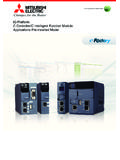Transcription of EDEXCEL NATIONAL CERTIFICATE/DIPLOMA …
1 EDEXCEL NATIONAL CERTIFICATE/DIPLOMA . SELECTION AND APPLICATIONS OF PROGRAMMABLE LOGIC. CONTROLLERS. UNIT 25 - NQF LEVEL 3. OUTCOME 1 - SELECTION, HARDWARE AND REQUIREMENTS. TUTORIAL 2 - BASICS OF PLC TECHNOLOGY. CONTENT. 1 Understand the selection, hardware and software requirements of a programmable controller Programmable controller selection: criteria cost, versatility and scanning time; internal architecture central processing unit (CPU), arithmetic and logic unit (ALU), flags, registers, memory and types (volatile, non-volatile); scan cycle (self-test, input/logic/output scans). System hardware and software requirements: manufacturers' specification of input/output (I/O) units (digital and analogue); power supply; use of operating system; configuration of inputs and outputs; number systems binary, octal, hexadecimal, binary-coded decimal (BCD); input/output devices; mechanical switch relays (electromechanical and solid state).
2 Transducers temperature, pressure, flow, smart sensors, simple motors and drives 1. 1. PURPOSE AND ORIGINS. The PLC has its origins in the motor manufacturing industries. manufacturing processes were partially automated by the use of rigid control circuits, electrical, hydraulic and pneumatic. It was found that when ever a change had to be made, the system had to be rewired or reconfigured. The use of wiring boards on which connections could be changed by unplugging them and changing them around followed. With the development of micro-computers it was realised that if the computer could switch things on or off and respond to a pattern of inputs, then the changes could be made by simply reprogramming the computer and so the PLC was born.
3 There are still many applications of automated systems with permanent connections to perform a single control action. Often the system uses logic components to produce the correct action (electronic and pneumatic). The PLC mimics this process by performing the logical operations with the programme rather than with real components. In this way cost savings are produced as fewer components are needed and more flexibility is introduced as programmes can be changed more easily than reconfiguring a hard ware system. Programming is covered in Outcomes 2 and 3. A Programmable Logic Controller is a mini computer specifically designed for industrial and other applications. Examples are: Automated machines (pneumatic, hydraulic and electric actuators).
4 Robots ( for assembly work, paint spraying, welding and so on). Production processes ( machine tools). Signalling systems ( traffic lights). Process Control ( sugar refining and power stations). 2. ARCHITECTURE AND TERMINOLOGY. The PLC activates its output terminals in order to switch things on or off. The decision to activate an output is based on the status of the system's feed-back sensors and these are connected to the input terminals of the PLC. The decisions are based on logic programmes stored in the RAM and/or ROM memory. They have a central processing unit (CPU), data bus and address bus. A typical unitary PLC is shown below. Figure 1. 2. The next diagram shows a very oversimplified diagram of the structure.
5 The Central processing Unit controls everything according to a programme stored in the memory (RAM or ROM). Everything is interconnected by two busses, the address bus and the data bus (shown as a single red line). The system must be able to communicate with external devices such as programmers, display monitors and Analogue/Digital converters. Figure 2. THE CPU. The next diagram shows the internal structure of the Central Processing Unit in its simplest form. It usually contains (but sometimes it is external and separate) an Arithmetic Logic Unit (ALU). This is the part that performs operations such as adding, subtracting, multiplying, dividing and comparing. The Buffers act as switches that isolate the lines on either side if required.
6 A, B and C. are latches that passes the data from one side to the other when told to do so. Digital data is passed around through busses. The busses were originally 4 parallel lines but as technology progressed this become 8, then 16 and now 32. Digital numbers and how they are put onto busses is explained in outcome 2. The busses are connected to memory chips. In a memory chip, digital numbers are stored in locations. The number is the data and the location is the address. Data can be sent to or brought from memory locations by either writing it or reading. The lines labelled R and W are signal lines that makes the CPU read or write. A REGISTER is a temporary memory location where data is put to be manipulated and then taken away.
7 The CLOCK line is pulsed at a regular rate to synchronise the operations. Currently this has reached a rate measure in Giga Hertz (1000 million times a second). The Reset line when activated resets the programme Counter to Zero. The operations are carried out to a set of instruction (the programme) and these are decoded in the ID (Instruction Decoder). 3. Figure 3. INPUT MODULE. The input module connects the input terminals to the rest of the system. The input voltage from the switching device is typically 24 V but manufacturers make them work on a range of voltages included 110V in some cases. Typically the inputs are electrically isolated from the internal electronics by OPTO ISOLATORS. This is a way of passing on the status of the input (on or off) by use of a light emitting diode and phototransistor.
8 A typical opto isolator is shown. They have the advantage of reducing the effects of spurious pulses generated from electro magnetic sources. It is also a safety feature to prevent live voltages appearing on the input lines in the event of a fault. Figure 4. OUTPUT MODULE. The output module contains switches activated by the CPU in order to connect two terminals and so allow current to flow in the external circuit. This will activate devices such as pneumatic solenoid valves, hydraulic solenoid valves, motors, pipe line valves, heating elements and so on. Care must be taken not to overload the contacts. The switch may be a transistor or a relay. The diagram shows a typical output arrangement. The terminals are numbered and these numbers are used in the programme.
9 The voltage and current that may be switched depends on the manufacturer's model. Figure 5. 4. MEMORY. The PLC has RAM (Random Access Memory) and ROM (Read Only Memory). The programme, when written and entered, is stored in the RAM. The ROM contains permanent programmes such as that required to monitor the status of the inputs and outputs and to run diagnostic tests. Memory may be also classes as volatile or non-volatile. The contents of volatile memory are only retained so long as power is maintained to the memory chip and depends on a backup battery to maintain the data when the unit is switched off. This is most likely to be used for RAM. Non-volatile memory retains the data and is most likely to be used for ROM.
10 It may not be possible to change the stored contents once the data is stored in this memory. For example magnetic storage devices and CD. storage devices are non-volatile but in these units it is more likely to be flash memory chips. Volatile memory is faster to access and write to than non-volatile. REGISTERS are a memory location containing a digital number. The difference between a register and any other memory location is that the bits may be manipulated under control of the programme by being shifted or rotated. FLAGS are single bits in a register that are switched on to indicate the status of something. TESTING. The PLC has certain diagnostic, monitoring and testing facilities within the software. Light Emitting Diodes (LED) shows the status of the inputs and outputs.















